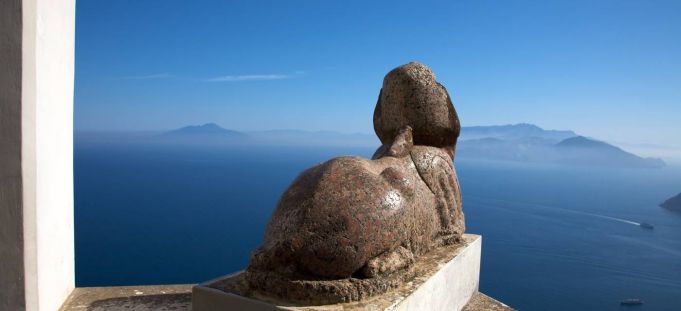The dream house of a legendary Swedish doctor and a secret love affair on the island of Capri.
Almost a century ago, The Story of San Michele by Swedish doctor Axel Munthe was a runaway bestseller. Translated into 50 languages, it has sold millions of copies all over the world and continues to be republished regularly up to the present day.
The San Michele of the title was the house that Munthe built for himself in the village of Anacapri on the island of Capri. It stands on a rocky outcrop 325 metres above the sea, with sweeping views over the Bay of Naples and the Sorrentine peninsula. It is one of Capri's main tourist attractions, on a par with the Blue Grotto.
The house was a dream that Munthe built to his own design, with, in his own words: “columns of priceless marble, supporting loggias and arcades, beautiful fragments from past ages strewn all over my garden, the chapel turned into a silent library with cloister stalls round the walls and sweet-sounding bells ringing Ave Maria over each happy day.”
Privileged retreat
Munthe died more than 70 years ago, at the ripe old age of 91. He did not die in Capri, as he would have wished, but at the Royal Palace of Stockholm, where he was often a guest during the winter.
However, he left an indelible imprint on the island. The villa has been left as he created it, with his furniture and his eccentric collection of curios and antiquities, acquired over a lifetime. In his will, he bequeathed it to the Swedish crown and it is now run by the Swedish Institute in Rome as a museum and a privileged retreat for scholarship-winning artists, researchers, students and journalists who can spend some time there dedicated to study and creativity.
The present curator, writer and journalist Kristina Kappelin, gave us a guided tour of the house and the delightful garden, pointing out some of Munthe's most unusual acquisitions, such as the Medusa head – which he claimed in his book to have spotted lying on the seabed from the height of the villa terrace – and the granite Egyptian sphinx that sits majestically at the end of the columned pergola along the edge of the cliff. Munthe recounted that he had located it in some remote area of Calabria, guided by a mysterious voice in a dream.
The Story of San Michele, in fact, is a fascinating mix of true anecdotes from his highly unusual life story and imaginary encounters with spirits and mythological beings. However, nobody really knows how he came by many of his trophies and exhibits, though it was murmured that he rummaged diligently through the Naples flea markets.

The tour through the house includes the sculpture court, the large kitchen and the living quarters which are, as Munthe wanted, open and full of light.
When he began converting the original farmhouse and ruined chapel of St Michael that made up the original nucleus of his house, he discovered a wealth of marble fragments, pieces of ancient statuary and a section of frescoed wall, all of which convinced him that the site had once been part of a palace belonging to the Roman emperor Tiberius.
The wisteria-covered colonnade leads onto the point where the mysterious sphinx presides, perched high and facing the sea. The ancient Phoenician stairway, with over seven hundred steps cut out of the cliffside, starts here. This was the only link between Capri and Anacapri when Munthe first arrived.
The road followed later, and nowadays there is a convenient minibus service to convey the endless stream of tourists from Capri port to the villa.Munthe spent almost all his summers on Capri, where he could escape from the pressures of his work as a high-society doctor in Rome.
During the 19th and early 20th century, the aristocracy and wealthy industrialists of Europe regularly came south each year for the benefit of their health. In an era when tuberculosis was rampant, doctors recommended their patients spend some months in the warmer Mediterranean climate, and Rome was a favourite destination.
Colourful career
The Story of San Michele is a rambling but highly entertaining account of his life and his colourful career as doctor to the fashionable set of international travellers who flocked to Italy.
Munthe set up his surgery in Rome at Piazza di Spagna 26, the same building where the poet John Keats had drawn his last breath some 70 years previously. Medical studies were just starting to focus on the causes of mental illnesses and Munthe was among the first to realise that many of his patients' complaints were psychosomatic, caused by the idle lifestyle and the frustrations of the wealthy young women he treated.
He did not, however, limit his practice to the rich, but he also treated the poor in the city slums free of charge, and he went voluntarily to Naples during the 1884 cholera epidemic to help the sufferers.
In the book, Munthe is reticent about his private life, which did not run smoothly. He was married twice, with an acrimonious separation from his second wife Hilda, the mother of his two sons. However, unbeknown to the rest of the world, he was involved in a long-term love affair that was one of his best-kept secrets.
A royal affair
“This has all come out fairly recently," Kappelin told us. "For 37 years Munthe had a secret relationship with Victoria, the Crown Princess of Sweden. She suffered from poor health and he was appointed her personal doctor, accompanying her on many of her journeys between Sweden and Italy."
The princess's marriage to Prince Gustav of Sweden was not a happy one, and after the birth of her last son she lived more or less apart from her husband. In a letter, she confessed to Munthe that there was "nothing between the Crown Pr. & myself except quiet talks." The princess and her doctor had a lot in common. They shared a love of animals (Munthe had around six dogs in Capri, as well as a number of unusual pets, like Billy the baboon, a mongoose and a little owl). Both loved art, literature, archaeology and music, and both were also keen photographers.
Although their friendship did give rise to gossip, the love affair was successfully concealed from the court and public, as recounted by literature professor Bengt Jangfeldt in his book Axel Munthe. The Road to San Michele, first published in 2003. Jangfeldt is the first researcher to have undertaken an in-depth study of Munthe's private papers and diaries, bringing to light many little known aspects of his life.
Munthe himself never mentions Victoria in his book. The only clues lie in the name of his cutter, the "Lady Victoria", and in a passage where he alludes to "a gracious lady [who], although she has to be the mother of a whole country, my own country, has enough room left in her heart to bring a bunch of flowers to the grave of a dog, for 12 years her faithful friend, every time she comes to Capri."
In public, the couple had agreed to maintain a purely formal front. "Remember you must treat me with the greatest indifference, rather as a bore," Munthe wrote to her.They also took the precaution of speaking together in English when servants were around so that their conversations would not be understood.
Their relationship continued when Victoria became Queen Consort in 1907 and lasted until her death in 1930. Afterwards, Munthe kept up a friendly relationship with Victoria's husband, the widower who had always turned a blind eye.
Love of animals
Munthe's love of animals led him to clash with the islanders. The mountains of Capri were a favoured resting spot for migrating songbirds and quails, which the local people netted and killed by the thousands to grace the tables of Paris restaurants.
Axel was determined to curtail the practice and almost bankrupted himself to purchase the nearby Monte Barbarossa from the landowner, a brutal ex-butcher who kept putting up the price.
The matter was settled when the butcher fell ill and implored il dottore to come and save him. Thus Munthe finally got his way and was able to establish his bird sanctuary on the mountainside. Although the hunting of birds is now banned on Capri, the sanctuary still exists and guided tours can be arranged through the Villa.
International celebrity
Meanwhile, Munthe became an international celebrity. His visitors included people like Oscar Wilde and his lover Lord Alfred Douglas in 1897, Henry James (1899), the Empress Eugenie, Napoleon III's widow (1899), Greta Garbo (1938), Compton Mackenzie and Gabriele D'Annunzio (in the 1920s).
Munthe did not spend his last years in Capri, as he would have wished. The second world war intervened, making travel to Italy impractical and when the war ended he was too old and frail to undertake the journey.
In a letter he wrote to the publisher John Murray, he sadly remarked, "I shall never see Capri again. I did not know it was so difficult to die and die alone." He slipped into a coma and died on 11 February 1949. His sons scattered his ashes, not in the Mediterranean, but in the North Sea.
By Margaret Stenhouse
For information on visiting San Michele tel. (+39) 0818371401 or see website.
This article was published in the July 2019 edition of Wanted in Rome magazine.
General Info
View on Map
The Myth of San Michele on the Isle of Capri
Viale Axel Munthe, 34, 80071 Anacapri NA, Italia


















